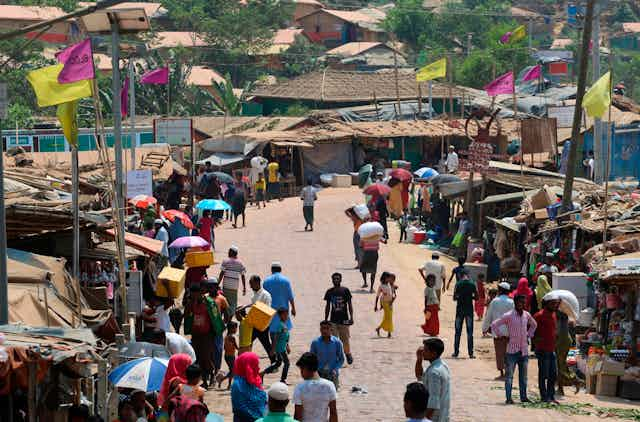Coronavirus is spreading quickly in densely populated Bangladesh, despite a nationwide shutdown put in place a month ago.
This preventive measure has proven challenging to implement due to lack of awareness of the coronavirus and the absence of a social safety net. Extreme poverty also forces many Bangladeshis to keep working and looking for food despite the risks. Bangladesh had 2,948 confirmed COVID-19 cases as of April 20.
The disease has not yet spread into the refugee camps that house the Rohingya Muslims who fled ethnic violence in Myanmar in 2017, according to a recent update from the humanitarian organizations that work in the camps. But an outbreak in the overcrowded camps is almost certain to come eventually – and when it does, experts say, the damage could be severe.
Crisis response in the camps
Even in normal times people in refugee camps often struggle to survive, living as they do with minimal resources, food and housing. I saw this grim reality with my own eyes when I visited the Rohingya refugee camps in Bangladesh – my home country – in 2017 and 2018.
Many of the Rohingya I met in the Kutupalong and Balukhali camps had seen family members murdered and tortured. Most had experienced or borne witness to rape and had their houses burned down.
The Myanmar military’s violent 2017 assault on this Muslim minority was later declared a “textbook example of ethnic cleansing” by the United Nations.

The nearly 1 million traumatized Rohingya who migrated to neighboring Bangladesh now live in cramped, makeshift housing in the country’s southeast, near the border with Myanmar. In the camp areas, the basic hygiene that is essential for preventing the spread of the disease is simply impossible.
On average, four to five Rohingyas live together in a one-room hut, which is often constructed of tarpaulin sheets and bamboo sticks. Their floors, where they sleep on plastic cloth or paper, are usually muddy. Water supply, sanitation and sewage facilities are terribly inadequate.
The camps, which have an average density of 103,600 people per square mile – far denser than Manhattan – are a breeding ground for disease. Since 2017 cholera, chicken pox and diphtheria have broken out in the camp areas.
Preventive measures
The Bangladesh government, national aid groups and international agencies, including the United Nations, are trying to equip the refugee camps for the coming COVID-19 pandemic.
Nearly 6,000 hand-washing stations have been installed since March, and some 9,000 shared bathing facilities and toilets disinfected. Half a million bars of soap have gone out at the distribution centers where residents get their food and household supplies, according to humanitarian groups that work in the camps.
Aid organizations are also starting to get face masks to residents. Some 10,000 cloth face coverings have been sewn so far.
Despite these efforts, soaps, face masks and hand sanitizer remain out of reach for many Rohingya.

To ensure that the refugees understand the threat of COVID-19 and know how to protect against it, the World Health Organization recently conducted a training on infection control for staff in all clinics and facilities serving in Rohingya camp areas. Personal hygiene conversations are already happening along with soap distribution.
Soon more than 1,400 trained health work volunteers will be doing education and outreach with refugees in the camps regarding the need for hand-washing, social distancing and other preventive measures.
Faith and health
But reports from the camp suggest that some Rohingya are ignoring this advice, relying instead on the traditional medicines and spiritual guidance of folk healers. Back in Myanmar, the Rohingya were politically and geographically marginalized. Most would have had little to no experience with public health prior to arrival at the camp.
Effectively engaging a marginalized community like the Rohingya in a coronavirus response will require camp authorities to deliver information in a locally relevant, culturally sensitive fashion.

History suggests that means working more closely with refugees themselves, as well as with local religious leaders and folk healers. During the Ebola outbreak in the Democratic Republic of the Congo, faith leaders played a critical part in reaching one of the most hard-to-reach Pygmy communities.
Even if widely embraced, social distancing will prove difficult in the refugee camps. To get food, people must go to central distribution areas. Bathrooms are often shared. Poverty effectively prevents commerce from closing down entirely.
For now, fear about the coming COVID-19 outbreak is spreading among the Rohingya. One night in late March, when people in the camps were sleepless with anxiety, Time magazine reports, prayers were chanted at midnight as imams and the faithful sought God’s protection.
Working urgently
With very limited resources, the humanitarian agencies and local government are working together closely to address urgent shortages in the camps.
Bangaldesh’s refugee relief and repatriation commissioner, Mahbub Alam Talukder, says there are “sufficient” coronavirus testing kits for Rohingya camps. Efforts are underway to ready up to 1,900 hospital beds across Cox’s Bazar, the Bangladeshi port city that is home to about 2 million locals and 1 million Rohingya refugees.
As of April 6, however, Save the Children – one of the aid organizations serving the camps – reported that the city had not a single ventilator. In all of Bangladesh, there are just 1,169 intensive care beds with ventilators, according to the Dhaka Tribune newspaper – roughly one for every 93,000 people.
“It is difficult for Bangladesh to meet the expected surge in demand for ventilators,” said Dr. Shamim Jahan, Bangladesh deputy director for Save the Children, in a press release.
Jahan is calling for international assistance to “avert a humanitarian disaster” in the refugee camps, “[N]o single country can confront COVID-19 alone.”
Pradipto Vaskar Rakshit, an education specialist working at the Cox’s Bazar refugee camps in Bangladesh, contributed to this article.

